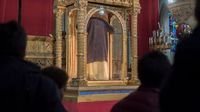Starting from Easter and continuing for three weeks, the small town of Argenteuil in France is preparing to welcome an extraordinary influx of pilgrims. Nearly 400,000 people are expected to venerate the Sainte Tunique, believed to be the tunic worn by Jesus Christ during his Passion, from April 18 until May 11, 2025. This significant event, known as an ostension, is a rare opportunity for the faithful to witness one of Christianity's most revered relics.
The Sainte Tunique is not just any relic; it is considered one of the greatest in Christianity, alongside the crown of thorns from Notre-Dame, the shroud of Turin, and the shroud of Oviedo in Spain. According to tradition, the tunic was given to Charlemagne by Empress Irene of Byzantium on August 12, 800, and then passed down to his daughter, Théodrade, who was a nun at the monastery in Argenteuil. This historical connection adds to the allure of the relic.
During the ostension, which will commence on Good Friday, the tunic will be displayed in a manner that is rarely seen. Typically, the tunic is rolled up in a shrine, visible only through a small glass window. However, for this event, it will be unrolled and placed on a mannequin inside a large glass reliquary, allowing pilgrims to get a closer look.
In 2016, the last ostension attracted 200,000 visitors, and this year, the diocese of Pontoise is anticipating double that number. To accommodate the expected influx, they have already recruited 800 volunteers to assist pilgrims during their visit. The basilica will remain open all night to allow for continuous veneration.
The Sainte Tunique has been subjected to scientific scrutiny over the years, and a carbon-14 dating performed in 2004 by the Laboratoire des sciences du climat et de l’environnement indicated that the fabric dates back to between 530 and 650 AD, with a 95.4% probability. This has sparked debate about its authenticity, as some argue that the tunic could not have belonged to Jesus, given the dating results.
Father Guy-Emmanuel Cariot, the rector of the basilica and an exorcist priest in the diocese, acknowledges the challenges surrounding the tunic's authenticity. He states, "There is no absolute proof, but we have an avalanche of elements of authenticity. After that, it's up to each person to form their own opinion." He emphasizes that while the scientific evidence may raise doubts, the spiritual significance of the relic remains profound for many.
Despite the scientific skepticism, the tunic is believed to bear traces of human blood, which some claim corresponds to the blood type AB found on the Shroud of Turin. Additionally, pollen from the Jerusalem region has been found on the fabric, suggesting its origins may indeed be tied to the Holy Land. However, experts caution that pollen cannot be definitively dated, and its presence may not be as conclusive as some believe.
The history of the Sainte Tunique is also marked by significant events, including its burial during the French Revolution. To protect it from confiscation by the state, the curate of Argenteuil cut the tunic into pieces and buried them on November 18, 1793. This dramatic act adds another layer of intrigue to the relic's storied past.
As the ostension approaches, security measures are being put in place to ensure the safety of the expected crowds. Approximately 200 police officers will be deployed daily in downtown Argenteuil to manage the influx of pilgrims and maintain order.
On April 26, 2025, a special service will be held where representatives from various Christian denominations will gather to profess the Credo together. This event is intended to foster unity among different branches of Christianity, marking a significant moment in the celebration of the tunic.
Father Cariot reflects on the spiritual impact of the relic, stating, "People talk about graces of peace and inner liberation. This is the work of God, and it does not belong to us." He believes that the Sainte Tunique serves as a tangible connection to the divine for many believers, facilitating a deeper encounter with God.
As the basilica prepares for the arrival of thousands, the anticipation is palpable. Father Cariot notes that the theme for this year's ostension is based on a verse from the Epistle of Saint Paul to the Galatians: "Christ loved me and gave himself for me" (Galatians 2:20). He hopes that this focus will encourage pilgrims to reflect on the significance of Christ's sacrifice and the essence of their faith.
The Sainte Tunique of Argenteuil is more than just a relic; it is a symbol of faith, history, and the enduring connection between the past and present. As the faithful gather to honor this sacred garment, they are reminded of the powerful legacy of their beliefs and the hope that continues to inspire them today.







